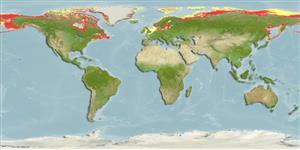分類 / Names
俗名 | 同種異名 | Catalog of Fishes(屬, 種) | ITIS | CoL | WoRMS | Cloffa
Teleostei >
Perciformes/Cottoidei (Sculpins)
鮋形目 (Sculpins) >
Cottidae (Sculpins)
杜父魚科 (Sculpins)
Etymology: Myoxocephalus: Greek, myos = muscle, and also, mouse + Greek, kephale = head (Ref. 45335); quadricornis: From Lönnberg..
More on author: Linnaeus.
Issue
Some authors use the genus Triglopsis for this species. See the list of references in Eschmeyer (CofF ver. Sep. 2011: Ref. 88002). More studies are needed.
Environment: milieu / climate zone / depth range / distribution range
生態學
海洋; 淡水; 半鹹淡水 居於水底的; 深度上下限 0 - 100 m (Ref. 58496). 極; 83°N - 41°N, 180°W - 180°E
Atlantic and Arctic: Baltic coast of Sweden, Finland, Russia and southwestern to eastern Poland; western coast of Sweden to northern coast of Norway, eastward to White and Barents Sea basins. In Siberia eastward to about Anadyr estuary. Landlocked populations in Sweden, central Finland and Karelia (Ref. 59043). Arctic drainages of North America (Ref. 5723).
北大西洋與北極圈: 通常在 60 ° N 之上但是在新斯科舍省達到 45 ° N。 倖存族群在深的而且寒冷的淡水湖泊北美洲與歐洲北部。 在伯恩公約的附錄 3 中 (受保育的動物群).
Length at first maturity / 大小 / 重量 / 年齡
Maturity: Lm ? range ? - ? cm
Max length : 60.0 cm TL 雄魚/尚未辨別雌雄; (Ref. 2058); common length : 30.0 cm TL 雄魚/尚未辨別雌雄; (Ref. 2058); 最大體重: 260.00 g (Ref. 27547); 最大年齡: 14 年 (Ref. 12193)
背棘 (總數): 7 - 9; 背的軟條 (總數): 13-16; 臀棘 0; 臀鰭軟條: 13 - 17; 脊椎骨: 37 - 42. Identified by the four bony protuberances on the top of the head (the protuberances are smaller in females and young and absent in the freshwater form), the chainlike lateral line, the sharp spines on the preoperculum, and the absence of palatine teeth (Ref. 27547). Gill rakers reduced to rounded, spiny protuberances (Ref. 27547). Soft dorsal often much enlarged in adult males; caudal truncate to slightly rounded (Ref. 27547). Young gray above, with three or four dark saddles below dorsal fins and a dark spot on dorsal side of caudal peduncle; adults are darker; spiny dorsal fin dusted with black; soft dorsal, anal, pectoral and caudal fins have dark bars; pelvic fins pale (Ref. 27547).
鑑定特徵為在頭部 (突起在雌性與幼魚中比較小而且不存在於淡水的形式) 的頂端,鏈狀的側線上的四個多骨的突起 , 在前鰓蓋骨上的銳利的棘, 與那缺乏顎齒.(參考文獻 27547) 鰓耙縮小成圓形又刺狀的突起了。 (參考文獻 27547) 軟的背部時常在雄性成魚中的非常大的; 尾部的截形略圓的.(參考文獻 27547) 幼魚上面灰色的, 有三條或四個深色的鞍狀斑在背鰭與一個深色的斑點之下在尾柄的背面兩側上; 成魚比較深色; 刺狀的背鰭有黑色色暈了; 軟的背鰭、臀鰭、胸鰭與尾鰭有深色的橫帶; 腹鰭灰白的.(參考文獻 27547)
Occurs in cold brackish and moderately saline water near the coast (Ref. 27547). Enters coastal rivers and may occur as far as 120 miles inland (Ref. 5723). Landlocked in lakes (Ref. 59043). Maximum depth reported at 100m (Ref. 35388). Benthic (Ref. 58426). Movements are limited to short onshore-offshore seasonal movements and mass movements of fry into shallow water in autumn (Ref. 28908, 28910). Moreover, there are no migrations of large numbers; movement into freshwater and long distances up rivers are apparently undertaken by relatively few individuals at a time (Ref. 27547). Diurnal from November to April but is largely nocturnal the rest of the year (Ref. 28905). Feeds on small crustaceans, fishes (Ref. 4968) and molluscs (Ref. 58426). Spawning takes place in shallow waters, male digs a groove in the gravel where pairing and egg laying occur. Move to deeper water in the spring, where they stay in summer (Ref. 35388). Landlocked populations are locally threatened (Ref. 59043).
出現於在海岸附近的寒冷半鹹淡水與一般鹹水;(參考文獻 27547) 進入沿海的河川而且可能在內陸 120 哩處出現遠達。 (參考文獻 5723) 最大的深度在 100 公尺報告。 (參考文獻 35388) 底棲的.(參考文獻 58426) 運動秋天時被僅限於短向陸及離陸的季節性的運動與魚苗大規模的運動進入淺水區。 (參考文獻 28908,28910) 而且, 有沒有大的數量迴游; 進入淡水與長的距離之內的運動從河口向上是由顯然地進行的相當少見的個體一次.(參考文獻 27547) 日行性從十一月到四月但是主要夜行的每年其他月份.(參考文獻 28905) 吃小型甲殼動物,魚 (參考文獻 4968) 與軟體動物。 (參考文獻 58426) 產卵發生於淺水域, 雄魚在成對與產的卵出現的礫石挖一個凹槽。 在春天移動到較深的水域, 在那裡它們停留在夏天中.(參考文獻 35388)
Life cycle and mating behavior
成熟度 | 繁殖 | 產卵場 | 卵 | 孕卵數 | 仔魚
Males become territorial and aggressive toward other males with the approach of the spawning season. Two or three days prior to spawning, the females become restless and swim about between short periods of rest. When a female swims over a male, he undulates his body from side to side and raises his spiny dorsal fin, If the female comes to rest near the male, he moves close to her in a series of short darts. Both then fan rhythymically with their pectoral fins, making a hole. The pair lie side by side, with the male's caudal fin twisted under that of the female. The male make rhythmic motions toward the female with his tail, and the motions apparently stimulate her to release her eggs (Ref. 28900, 28901). After spawning the female leaves the nest; the eggs are fanned and guarded by the male until hatching which occurs in the spring (Ref. 27547).北大西洋與北極圈: 通常在 60 ° N 之上但是在新斯科舍省達到 45 ° N。 倖存族群在深的而且寒冷的淡水湖泊北美洲與歐洲北部。 在伯恩公約的附錄 3 中 (受保育的動物群).
Robins, C.R., R.M. Bailey, C.E. Bond, J.R. Brooker, E.A. Lachner, R.N. Lea and W.B. Scott, 1991. Common and scientific names of fishes from the United States and Canada. Am. Fish. Soc. Spec. Publ. (20):183 p. (Ref. 3814)
人類使用
漁業: 自給性漁業
更多資訊
參考文獻養殖養殖資訊品種遺傳學Electrophoreses遺傳率疾病加工NutrientsMass conversion
工具
特別的報告
下載 XML
網路資源
Estimates based on models
Preferred temperature (Ref.
123201): -1.8 - 4.3, mean -1 °C (based on 6042 cells).
Phylogenetic diversity index (Ref.
82804): PD
50 = 0.5000 [Uniqueness, from 0.5 = low to 2.0 = high].
Bayesian length-weight: a=0.00724 (0.00579 - 0.00906), b=3.14 (3.08 - 3.20), in cm total length, based on LWR estimates for this species (Ref.
93245).
營養階層 (Ref.
69278): 3.9 ±0.62 se; based on food items.
回復力 (Ref.
120179): 低的, 最小族群倍增時間4.5 - 14 年 (tm=3-5; tmax=14; Fec=792).
Fishing Vulnerability (Ref.
59153): Moderate vulnerability (44 of 100).
Nutrients (Ref.
124155): Calcium = 73.6 [14.2, 243.1] mg/100g; Iron = 0.358 [0.135, 1.153] mg/100g; Protein = 18.6 [15.8, 20.9] %; Omega3 = 0.493 [0.205, 1.367] g/100g; Selenium = 13.3 [5.5, 31.9] μg/100g; VitaminA = 9.77 [2.06, 48.14] μg/100g; Zinc = 0.784 [0.313, 1.423] mg/100g (wet weight);
